NCERT Solutions for Class 10 Maths Chapter 10 Circles
Circles are among the most important concepts of geometry and can be seen all around us in everyday life. A circle is the set of all points in a plane that lie at a fixed distance, i.e. the radius, from a given point, which is called the centre. The circular shape of gears, pulleys, and wheels facilitates unbroken and smooth motion in vehicles, machines, and clocks. In this chapter, you will learn the theorems and the properties related to the circles that will help you visualise the beauty of geometry. NCERT Solutions for Class 10 can help the students understand these concepts and will make them more efficient in solving problems involving Circles.
This Story also Contains
- NCERT Solutions for Class 10 Maths Chapter 10 Circles: Download Free PDF
- NCERT Solutions for Class 10 Maths Chapter 10 Circles (Exercise)
- Circles Class 10 NCERT Solutions: Exercise-wise
- Class 10 Maths NCERT Chapter 10: Extra Question
- Circles Class 10 Chapter 10: Topics
- NCERT Important Formula & Notes for Class 10 Maths Chapter 10 Circles
- Why are Class 10 Maths Chapter 10 Circles question answers important?
- NCERT Solutions for Class 10 Maths: Chapter Wise
- NCERT Books and NCERT Syllabus
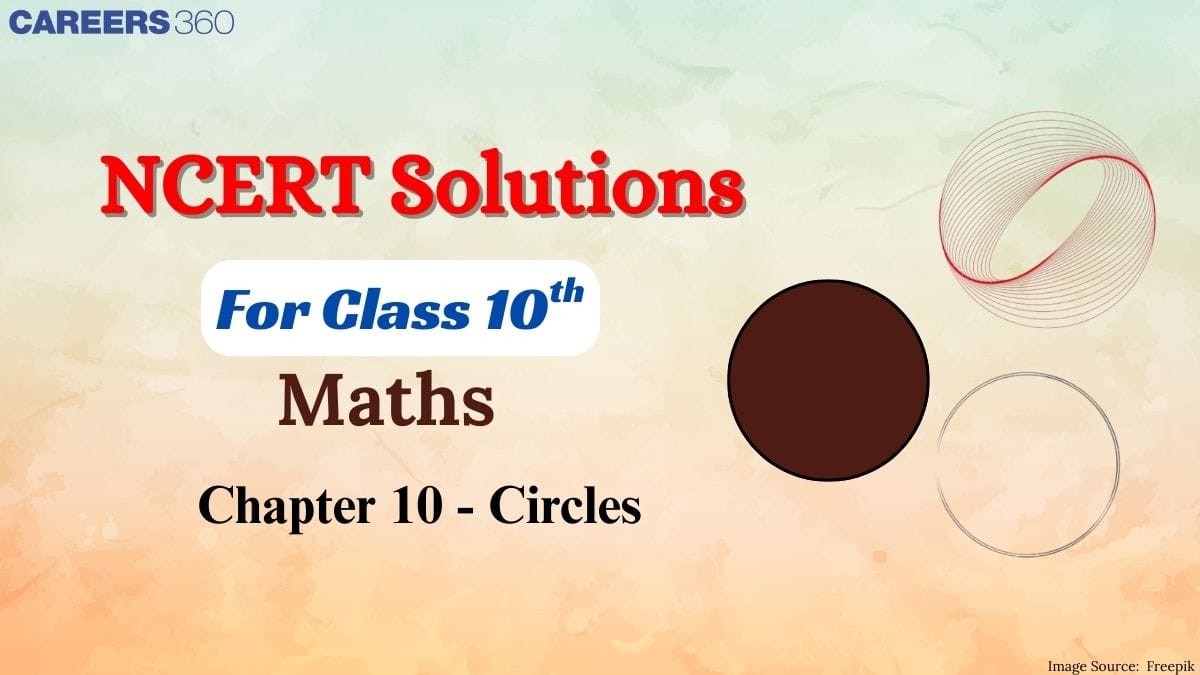
These NCERT Solutions for class 10 Maths are designed by our experienced subject experts to offer clear and step-by-step solutions for the exercise problems and help students to prepare well for exams and to gain knowledge about all the natural processes happening around them through a series of solved questions. It covers questions from all the topics and will help you improve your conceptual knowledge and accuracy. Many toppers rely on NCERT Solutions since they are designed as per the latest syllabus. Explore NCERT Books, Solutions, Syllabus, and Exemplar Problems with Solutions for complete syllabus coverage in this NCERT article.
NCERT Solutions for Class 10 Maths Chapter 10 Circles: Download Free PDF
Careers360 brings you NCERT Class 10 Maths Chapter 10 Circles solutions, carefully prepared by subject experts to simplify your studies and help in exams. A downloadable PDF is available — click the link below to access it.
NCERT Solutions for Class 10 Maths Chapter 10 Circles (Exercise)
Below, you will find the NCERT Class 10 Maths Chapter 10 Circles question answers explained step by step.
| Circles Class 10 Question Answers Exercise: 10.1 Page number: 147 Total questions: 4 |
Q1: How many tangents can a circle have?
Answer:
The lines that intersect the circle exactly at one single point are called tangents. In a circle, there can be infinitely many tangents.
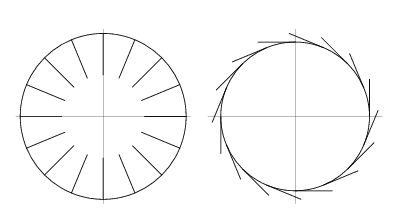
Answer:
(1) one
A tangent of a circle intersects the circle exactly at one single point.
(2) secant
It is a line that intersects the circle at two points.
(3) Two,
There can be only two parallel tangents to a circle.
(4) point of contact
The common point of a tangent and a circle.
(A) 12 cm
(B) 13 cm
(C) 8.5 cm
(D) $\sqrt { 119}$ cm
Answer:
The correct option is (D) = $\sqrt { 119}$ cm
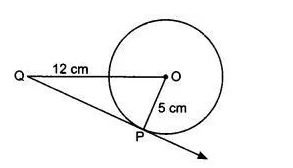
It is given that the radius of the circle is 5 cm. OQ = 12 cm
According to the question,
We know that $\angle QPO=90°$
So, triangle OPQ is a right-angle triangle. By using Pythagoras' theorem,
$PQ =\sqrt{OQ^2-OP^2}=\sqrt{144-25}=\sqrt{119}$ cm
Answer:

AB is the given line, and line CD is the tangent to a circle at point M that is parallel to line AB. The line EF is a second parallel to AB.
| Circles Class 10 Question Answers Exercise: 10.2 Page number: 152-153 Total questions: 13 |
(A) 7 cm
(B) 12 cm
(C) 15 cm
(D) 24.5 cm
Answer:
The correct option is (A) = 7 cm
Given that,
The length of the tangent (QT) is 24 cm, and the length of OQ is 25 cm.
Suppose the length of the radius OT is $l$ cm.
We know that $\Delta OTQ$ is a right-angle triangle. So, by using Pythagoras' theorem-
$\\OQ^2 = TQ^2+OT^2$
$⇒ l = \sqrt{25^2-24^2}$
$⇒OT = l=\sqrt{49}$

⇒ OT = 7 cm

(A) $60 ^\circ$
(B) $70 ^\circ$
(C) $80 ^\circ$
(D) $90 ^\circ$
Answer:
The correct option is (b)

In figure, $\angle POQ = 110°$
Since POQT is a quadrilateral. Therefore, the sum of the opposite angles is 180
$\\\Rightarrow \angle PTQ +\angle POQ = 180°$
$\Rightarrow \angle PTQ = 180°-\angle POQ$
$\Rightarrow \angle PTQ= 180°-100°$
$\Rightarrow \angle PTQ= 70°$
(A) 50°
(B) 60°
(C) 70°
(D) 80°
Answer:
The correct option is (A)
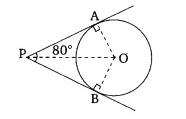
It is given that, tangent PA and PB from point P are inclined at $\angle APB = 80°$
In triangle $\Delta$ OAP and $\Delta$ OBP
$\angle OAP = \angle OBP = 90°$
OA =OB (radii of the circle)
PA = PB (tangents of the circle)
Therefore, by SAS congruence
$\therefore \Delta OAP \cong \Delta OBP$
By CPCT, $\angle OPA = \angle OPB$
Now, $\angle$ OPA = $\frac{80}2$ = 40°
In $\Delta$ PAO,
$\angle P + \angle A + \angle O = 180°$
$\angle O = 180° - 130°$ = 50°
Q4: Prove that the tangents drawn at the ends of the diameter of a circle are parallel.
Answer:
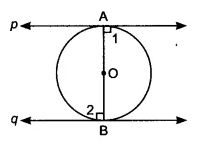
Let line $p$ and line $q$ be two tangents of a circle, and AB is the diameter of the circle.
OA and OB are perpendicular to the tangents $p$ and $q$, respectively.
therefore,
$\angle1 = \angle2 = 90°$
$\Rightarrow$ $p$ || $q$ {$\because$ $\angle$ 1 & $\angle$ 2 are alternate angles}
Answer:

In the above figure, the line AXB is tangent to a circle with centre O. Here, OX is perpendicular to the tangent AXB ( $OX\perp AXB$ ) at the point of contact X.
Therefore, we have,
$\angle$ BXO + $\angle$ YXB = $90°+90°=180°$
$\therefore$ OXY is a collinear
$\Rightarrow$ OX is passing through the centre of the circle.
Answer:

Given that,
The length of the tangent from point A (AP) is 4 cm, and the length of OA is 5 cm.
Since $\angle$ APO = 90°
Therefore, $\Delta$ APO is a right-angle triangle. By using Pythagoras' theorem;
$OA^2=AP^2+OP^2$
$⇒5^2 = 4^2+OP^2$
$⇒OP=\sqrt{25-16}=\sqrt{9}$
$⇒OP = 3\ cm$
Answer:
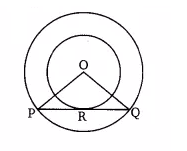
In the above figure, Pq is the chord to the larger circle, which is also tangent to a smaller circle at the point of contact R.
We have,
radius of the larger circle OP = OQ = 5 cm
radius of the small circle (OR) = 3 cm
OR $\perp$ PQ [since PQ is tangent to a smaller circle]
According to the question,
In $\Delta$ OPR and $\Delta$ OQR
$\angle$ PRO = $\angle$ QRO {both $90°$ }
OR = OR {common}
OP = OQ {both radii}
By RHS congruence $\Delta$ OPR $\cong$ $\Delta$ OQR
So, by CPCT
PR = RQ
Now, In $\Delta$ OPR,
by using Pythagoras' theorem,
$PR = \sqrt{25-9} =\sqrt{16}$
PR = 4 cm
Hence, PQ = 2, PR = 8 cm
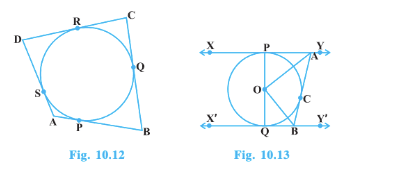
Answer:
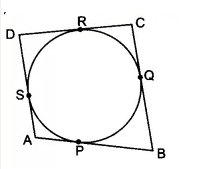
To prove- AB + CD = AD + BC
Proof:
We have,
Since the length of the tangents drawn from an external point to a circle is equal
AP =AS .......(i)
BP = BQ.........(ii)
AS = AP...........(iii)
CR = CQ ...........(iv)
By adding all the equations, we get;
AP + BP +RD+ CR = AS +DS +BQ +CQ
$\Rightarrow$ (AP + BP) + (RD + CR) = (AS+DS)+(BQ + CQ)
$\Rightarrow$ AB + CD = AD + BC
Hence proved.
Answer:
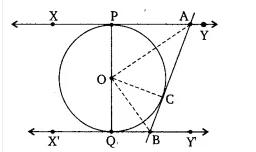
To prove- $\angle$ AOB = $90°$
Proof:
In $\Delta$ AOP and $\Delta$ AOC,
OA =OA [Common]
OP = OC [Both radii]
AP =AC [tangents from external point A]
Therefore by SSS congruence, $\Delta$ AOP $\cong$ $\Delta$ AOC
and by CPCT, $\angle$ PAO = $\angle$ OAC
$\Rightarrow \angle PAC = 2\angle OAC$ ..................(i)
Similarly, from $\Delta$ OBC and $\Delta$ OBQ, we get;
$\angle$ QBC = 2. $\angle$ OBC.............(ii)
Adding eq (1) and eq (2)
$\angle$ PAC + $\angle$ QBC = 180°
2( $\angle$ OBC + $\angle$ OAC) = 180°
( $\angle$ OBC + $\angle$ OAC) = 90°
Now, in $\Delta$ OAB,
The sum of the interior angles is 180°.
So, $\angle$ OBC + $\angle$ OAC + $\angle$ AOB = 180°
$\therefore$ $\angle$ AOB = 90°
Hence proved.
Answer:
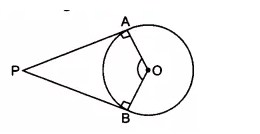
To prove - $\angle APB + \angle AOB = 180°$
Proof:
We have PA and PB as two tangents, and B and A are the points of contact of the tangents to a circle. And $OA\perp PA$, $OB\perp PB$ (since tangents and radius are perpendiculars)
According to the question,
In quadrilateral PAOB,
$\angle$ OAP + $\angle$ APB + $\angle$ PBO + $\angle$ BOA = $360°$
90° + $\angle$ APB + 90° + $\angle$ BOA = 360°
$\angle APB + \angle AOB = 180°$
Hence proved.
Q11: Prove that the parallelogram circumscribing a circle is a rhombus.
Answer:
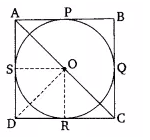
To prove that the parallelogram circumscribing a circle is a rhombus
Proof:
ABCD is a parallelogram that circumscribes a circle with centre O.
P, Q, R, and Sand are the points of contact on sides AB, BC, CD, and DA, respectively.
AB = CD .and AD = BC...........(i)
It is known that tangents drawn from an external point are equal in length.
RD = DS ...........(ii)
RC = QC...........(iii)
BP = BQ...........(iv)
AP = AS .............(v)
By adding eq (ii) to eq (v), we get;
(RD + RC) + (BP + AP) = (DS + AS) + (BQ + QC)
CD + AB = AD + BC
$\Rightarrow$2AB = 2AD [from equation (i)]
$\Rightarrow$ AB = AD
Now, AB = AD and AB = CD
$\therefore$ AB = AD = CD = BC
Hence, ABCD is a rhombus.
Answer:
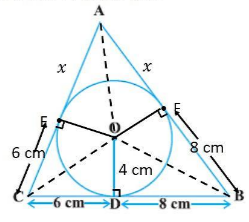
Consider the above figure. Assume centre O touches the sides AB and AC of the triangle at points E and F, respectively.
Let the length of AE be x.
Now in $\bigtriangleup ABC$ ,
$CF = CD = 6$ (tangents on the circle from point C)
$BE = BD = 6$ (tangents on the circle from point B)
$AE = AF = x$ (tangents on the circle from point A)
Now AB = AE + EB
$AB = AE + EB$
$ ⇒AB = x + 8$
$BC = BD + DC$
$⇒ BC = 8+6 = 14$
$CA = CF + FA$
$⇒ CA = 6 + x$
Now
$s = \frac{(AB + BC + CA )}2$
$ ⇒s = \frac{(x + 8 + 14 + 6 +x)}2$
$ ⇒s = \frac{(2x + 28)}2$
$⇒ s = x + 14$
Area of triangle $\bigtriangleup ABC$
$\\=\sqrt{s×(s-a)×(s-b)×(s-c)}$
$=\sqrt{(14+x)×[(14+x)-14]×[(14+x)-(6+x)]×[(14+x)-(8+x)]}$
$=4\sqrt{3(14x+x^2)}$
Now the area of $\bigtriangleup OBC$
$\\= (\frac12)×OD×BC\\\\ = (\frac12)×4×14\\\\ = \frac{56}2 = 28$
Area of $\bigtriangleup OCA$
$\\= (\frac12)×OF×AC \\\\= (\frac12)×4×(6+x) \\\\= 2(6+x) \\\\= 12 + 2x$
Area of $\bigtriangleup OAB$
$\\= (\frac12)×OE×AB \\\\= (\frac12)×4×(8+x) \\\\= 2(8+x) \\\\= 16 + 2x$
Now Area of the $\bigtriangleup ABC$ = Area of $\bigtriangleup OBC$ + Area of $\bigtriangleup OCA$ + Area of $\bigtriangleup OAB$
$⇒ 4\sqrt{3x(14+x)}= 28 + 12 + 2x + 16 + 2x $
$ ⇒4\sqrt{3x(14+x)} = 56 + 4x $
$⇒ 4\sqrt{3x(14+x)} = 4(14 + x) $
$⇒ \sqrt{3x(14+x)}= 14 + x$
On squaring both sides, we get,
$⇒3x(14 + x) = (14 + x)^2$
$ ⇒3x = 14 + x $
$⇒3x - x = 14$
$⇒ 2x = 14$
$ ⇒x = \frac{14}2$
$⇒x = 7$
Hence
AB = x + 8
⇒ AB = 7+8
⇒ AB = 15
AC = 6 + x
⇒ AC = 6 + 7
⇒ AC = 13
Answer- AB = 15 and AC = 13
Answer:
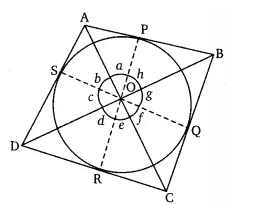
Given- ABCD is a quadrilateral circumscribing a circle. P, Q, R, and S are the points of contact on sides AB, BC, CD, and DA, respectively.
To prove-
$\\\angle AOB + \angle COD =180°\\ \angle AOD + \angle BOC =180°$
Proof -
Join OP, OQ, O, R, and OS
In triangle $\Delta$ DOS and $\Delta$ DOR,
OD =OD [common]
OS = OR [radii of the same circle]
DR = DS [length of tangents drawn from an external point is equal ]
By SSS congruency, $\Delta$ DOS $\cong$ $\Delta$ DOR,
and by CPCT, $\angle$ DOS = $\angle$ DOR
$\angle c = \angle d$ .............(i)
Similarly,
$\\\angle a = \angle b$
$ \angle e = \angle f$
$ \angle g =\angle h$ ...............(2, 3, 4)
$\therefore 2(\angle a +\angle e +\angle h+\angle d) = 360°$
$\\(\angle a +\angle e) +(\angle h+\angle d) = 180°$
$ \angle AOB + \angle DOC = 180°$
Similarily, $\angle AOD + \angle BOC = 180°$
Hence proved.
Circles Class 10 NCERT Solutions: Exercise-wise
Exercise-wise NCERT Solutions of Circles Class 10 Maths Chapter 10 are provided in the links below.
Class 10 Maths NCERT Chapter 10: Extra Question
Question:
If the angle made by a chord on the major arc of a circle is $50^{\circ}$, then what will be the angle made by the same chord on the minor arc of this circle?
Answer:
Angle made by a chord on the major arc of a circle $\angle ACB $ = $50^{\circ}$
Angle made by the same chord on the minor arc of the circle = $\angle ADB$
= $180^{\circ}-50^{\circ}$
= $130^{\circ}$
Hence, the correct answer is $130^{\circ}$.
Circles Class 10 Chapter 10: Topics
Topics you will learn in NCERT Class 10 Maths Chapter 10 Circles include:
- 10.1 Introduction
- 10.2 Tangent to a Circle
- 10.3 Number of Tangents from a Point on a Circle
NCERT Important Formula & Notes for Class 10 Maths Chapter 10 Circles
- Two concentric circles: The chord of the larger circle, which touches the smaller circle, is bisected at the point of contact.
- Properties of Tangents:
- A tangent to a circle touches it at exactly one point.
- At any given point on the circle, there is only one tangent.
- The radius through the point of tangency is perpendicular to the tangent.
- Number of Tangents:
- From a point inside the circle: No tangent can be drawn.
- From a point on the circle: Exactly one tangent can be drawn.
From a point outside the circle: Exactly two tangents can be drawn, and their lengths are equal.
Important Theorems:
- Theorem 10.1: The tangent at any point of a circle is perpendicular to the radius through the point of contact.
- Theorem 10.2: The lengths of tangents drawn from an external point to a circle are equal.
Why are Class 10 Maths Chapter 10 Circles question answers important?
Circles are an important part of geometry that help us understand how points and lines interact with round shapes. This chapter teaches us about tangents and how they touch a circle at only one point. These Class 10 Maths Chapter 10 Circles question answers help students practise and understand these ideas clearly. Here are some more points on why these question answers are important:
- These solutions help us learn how to draw and find tangents to a circle easily.
- These question answers make it easier to solve problems about the number of tangents from a point on a circle.
- These Class 10 Maths Chapter 10 Circles question answers prepare you for higher classes where you’ll study coordinate geometry and properties of circles in detail.
NCERT Solutions for Class 10 Maths: Chapter Wise
For students' preparation, Careers360 has gathered all Class 10 Maths NCERT solutions here for quick and convenient access.
Also read,
- NCERT Notes Class 10 Maths Chapter 10 Circles
- NCERT Exemplar Class 10 Maths Solutions Chapter 9 Circles
NCERT Exemplar Solutions - Subject Wise
Given below are the subject-wise exemplar solutions of class 10 NCERT:
NCERT Books and NCERT Syllabus
Here are some useful links for NCERT books and the NCERT syllabus for class 10:
Frequently Asked Questions (FAQs)
Exactly two tangents can be drawn from a point outside the circle, and they are equal in length.
Equal chords are equidistant from the centre, and chords equidistant from the centre are equal in length.
Angles subtended by an arc at the centre are equal to twice the angle at the circumference
The sum of opposite angles in a cyclic quadrilateral = 180°
Generally, this chapter holds significant weightage in the board exams every year. To obtain a good score in the 10th board exam, follow the NCERT book and the previous year's exam papers. More questions can be practised from the NCERT exemplar.
The key concepts covered in the NCERT Class 10 Maths Chapter 10 Circles include the introduction to circles, the properties of tangents to a circle, the calculation of the number of tangents from a point on a circle, and a summary of the entire chapter.
From any external point, exactly two tangents can be drawn to a circle. To learn more about how to draw these two tangents, study the Class 10 Maths Chapter 10 Circles.
The theorem states: The lengths of the two tangents drawn from an external point to a circle are equal.
That is, if PA and PB are the tangents from an external point P to a circle, then
PA=PB
Tangents to circles are widely used in real-life applications, such as:
- Wheel and road contact: The tire of a vehicle touches the ground exactly at one point, forming a tangent.
- Gears and mechanical engineering: In machines, tangents help in designing smooth contact between rotating parts.
- Architecture and design: Circular arcs and tangents are used in constructing bridges, domes, and curved pathways.
- Navigation and surveying: The concept of tangents helps in determining the shortest route or direct line of sight in fields like aviation and cartography.
Questions related to CBSE Class 10th
On Question asked by student community
HELLO,
I am attaching the link through which you can download and access the Bangalore Sahodaya Class 10th CBSE question paper of Mathematics ( Basic )
Here is the link :- https://school.careers360.com/download/ebooks/bangalore-sahodaya-class-10-mathematics-basic-question-paper-2025-26
It will help you to practice basic level numerical questions, strengthen fundamentals and prepare confidently for the board
HELLO,
Below i am attaching the direct link of Careers360 through which you can download the Bangalore Sahodaya Class 10th Mathematics Basic Question paper 2025 2026
Here is the link :- https://school.careers360.com/download/ebooks/bangalore-sahodaya-class-10-mathematics-basic-question-paper-2025-26
Hope this will help you!
Hello
You will be able to download the CBSE Class 10th Maths Sample Paper 2025-26 using the link which is given below.
https://school.careers360.com/boards/cbse/cbse-10th-maths-sample-papers-2025-26
I hope this information helps you.
Thank you.
Hello,
Here you can access the last 5 years CBSE Class 10 Board Exam Question Papers from the mentioned link below:
https://school.careers360.com/boards/cbse/cbse-previous-year-question-papers-class-10
Hope it helps.
You can check the Class 11 English half yearly question paper and answer key for 2025 26 on the Careers360 website. These papers help students practice, understand the exam pattern, and check their answers for better preparation.
You can visit this Careers360 link to access the English question paper and
Popular CBSE Class 10th Questions
Applications for Admissions are open.
As per latest syllabus. Physics formulas, equations, & laws of class 11 & 12th chapters
JEE Main Important Chemistry formulas
Get nowAs per latest syllabus. Chemistry formulas, equations, & laws of class 11 & 12th chapters
JEE Main high scoring chapters and topics
Get nowAs per latest 2024 syllabus. Study 40% syllabus and score upto 100% marks in JEE
JEE Main Important Mathematics Formulas
Get nowAs per latest syllabus. Maths formulas, equations, & theorems of class 11 & 12th chapters

